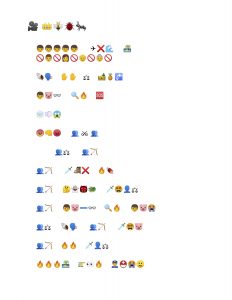
This was both a fun and challenging exercise (the best kind of exercise). I began the process by summarizing the plot using text and simple bullet points. These bullet points served as the “chapters” or lines of emojis that I would put into the story. As I considered the task, I wondered if it would be more useful to use phonetic representation of words or if symbols would be more helpful. As I actually started to conceptualize the translation, I relied almost entirely on symbolic uses of the emojis to represent ideas and people.
I was fortunate that my daughter just finished reading a classic book and had been waiting to watch the movie adaptation of the well-known story. Some of the symbols, for example, one used to represent the nickname of one of the characters, were used more to help identify the story for the reader rather than for their importance to the summary. This was based on an assumption that most of the readers would be familiar with the story and its symbols, and therefore was a conventional approach to telling the story based on assumed knowledge of the audience and their experience (Kress 2005).
One thing I learned through this process was that there is not an emoji for everything. I had not given emojis much thought or considered that a task like this would be limited by a finite availability of emojis, but that turned out to be the case; the title was not as easy to translate as anticipated. There were a few emojis that I assumed existed that I was not able to find.
I tried to rely on the repetition of some symbols to describe characters or groups in the story. The intention was that the repetition would help codify some of the elements so that the story might make sense. As Bolter (2005) describes, this allows the reader to move back and forth between the codified “glyphs” and the visual interpretation of the other emojis. However, this is still dependent upon the reader interpreting the symbols in the way that I intended and could easily lead to confusion or misinterpretation. With a finite alphabet of emojis, the ideas to be represented have to be quite simple.
References:
Bolter, J. D. (2001). Writing space: Computers, hypertext, and the remediation of print (2nd ed.). Mahwah, N.J: Lawrence Erlbaum Associates. doi:10.4324/9781410600110
Kress (2005), Gains and losses: New forms of texts, knowledge, and learning. Computers and Composition, Vol. 2(1), 5-22.
Ok, I’m gonna play my new game which is “come up with a movie script based on your intepretation of the emojis”!
Title: Royal Bugs
Plot:
There are many humans, but then all planes crash due to giant title waves and only islands remain at the top of mountains. All humans are gone.
A magic shell speaks, and the hands of god appear creating tents, pineapples, and fountains of drinking water.
Cut to 50 years later. Both humans and animals wear glasses. Someone dislikes the peace, and sets the world on fire using a magnifying glass. It’s a disaster.
People are furious. Everyone fights with one another (massive global fighting montage).
The fires burn every island. Helicopters try to save people. Many lives are lost, but the remaining few are smiling because they can create a new order amongst themselves now.
The end.
When reading your post, however, I realise that some of these glyphs may be names. I also relied on combining a few to try overcome emoji shortcomings, but it’s not always as easy at it looks! So, do you think more emojis should be added to the library, or that we don’t need more because we still have “traditional” textual communications which emojis simply enhance?
Thanks for sharing this 🙂
J
I love your interpretation Jamie! Thanks! It really helps to point out where my descriptions via emoji were not clear. The giant wave is misleading – I should have left it out. Some of your interpretation is somewhat correct, they do light the island on fire with the glass. I think by seeing other’s interpretations we could go back and revise based on what we learn from how others read it. This is a fun and enlightening exercise.